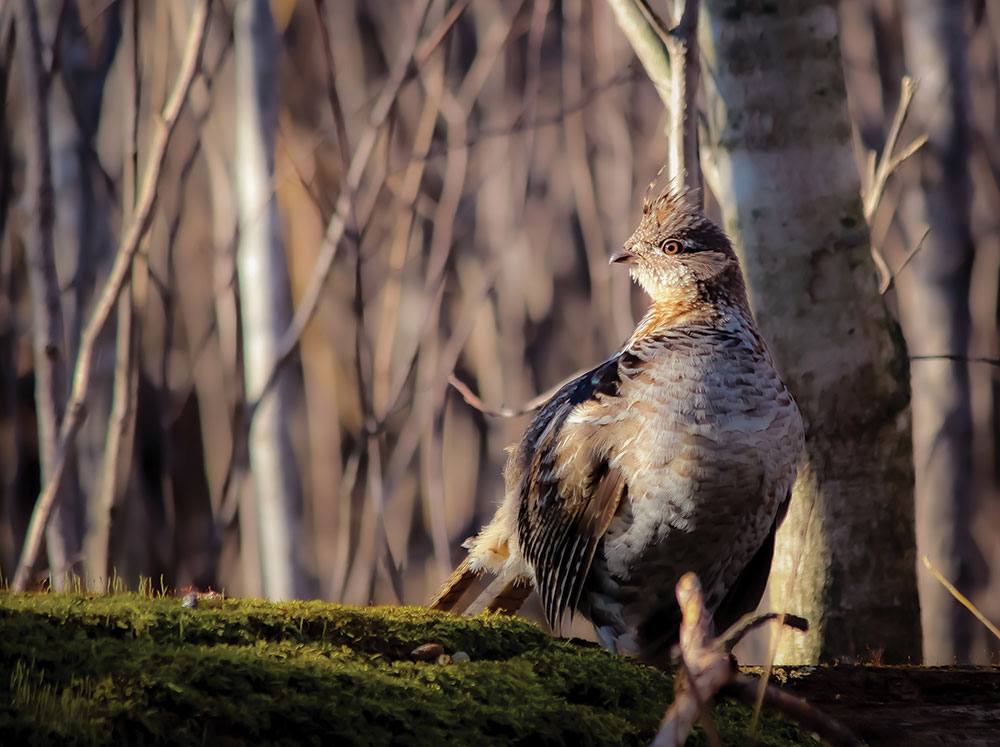Endangered Grouse

Ruffed grouse are likely to be added to the Endangered Species List in Indiana. How did we get here, and what are conservation groups doing to help “Ol’ Ruff”?
Ruffed grouse are disturbance-dependent birds, and with the decline of young forests across the state, there has been an ongoing debate about how to manage state forests. The Indiana Department of Natural Resources (DNR) and sportsmen’s groups have been working hard to educate elected officials and the general public on the importance of science-based forest-management practices and the benefits to wildlife. Unfortunately, there are groups working just as hard to prevent active management, making emotional appeals and claims that science does not support.
The problem is that policy decisions have real consequences for wildlife, and while we debate the issues, ruffed grouse, American woodcock, and many species of songbirds are disappearing from Indiana. These species depend on young forests for food and cover. The vast majority of state forests in Indiana, however, are classified as mature and are trending older. If the issue is not addressed quickly, there will be negative consequences for wildlife due to the lack of habitat. Although this article focuses on Indiana, the lack
of young-forest habitat is a nationwide issue.
The majority of the state forestland in Indiana was created by the DNR from what was once farmland. The DNR realized the need for forest habitat in the state and worked diligently to acquire and manage lands in the state forest system. Today, the DNR manages 15 state forest properties totaling hundreds of thousands of acres. Unlike state parks, where the focus is management for public recreation, the DNR’s goal for state forests is to create habitats that will support diverse, healthy, and sustainable fish and wildlife populations.
Some argue that the best way to accomplish these goals is by leaving the forests undisturbed. Many have an emotional connection to a place and feel that in order to protect it, it must not be actively managed. Others do not want forests disturbed because it is not aesthetically pleasing to them.
What many don’t understand, however, is that forests have been shaped for thousands of years by natural forces and then later also by anthropogenic, or non-natural, forces. Forest fires, flooding, drought, wind, ice, disease, and other natural disturbances affect forest structure and composition, and animals like elk and bison also influence forests. When the ice sheets retreated from present-day Indiana over 10,000 years ago, Native Americans girdled trees and set fires not only to clear land, but also to drive game and improve habitat. Later, European settlers cut trees and set fires for settlement and agriculture. These disturbances regenerated forests, and abandoned areas led to old-field succession that created a mosaic of early-successional habitats across the landscape.
Today we largely try to mitigate and often attempt to eliminate natural disturbances, and instead, use scientific forest-management practices to mimic natural disturbances. While harvesting timber may result in what some humans deem unsightly, it is important to keep in mind that forests will regenerate, and many wildlife species depend on these disturbances.
Left untouched, however, a once healthy and diverse forest will eventually lose diversity, and the quality of habitat for many species of wildlife declines. As the trees grow, the thick undergrowth dies off from lack of sunlight. The problem is that this undergrowth is used by many species—such as ruffed grouse, American woodcock, turkeys, white-tailed deer, songbirds, and a variety of reptiles and amphibians—as a source of food and cover.
Tools like selective timber harvests, controlled burns, and even clearcutting mimic the natural disturbances, like forest fires, that previously occurred more regularly. These disturbances replicate the natural forest cycle that have historically ensured that there were forests of different age classes across the landscape to provide a variety of food and habitat needs for wildlife. Without active management, populations of young-forest species like the ruffed grouse start to decline, which is the case in Indiana.
Historically, ruffed grouse inhabited all 92 counties in Indiana and were a popular gamebird. By 1983, however, it was confirmed that ruffed grouse had been extirpated from 43 counties in the state. Today, it’s believed that these birds only inhabit a very small portion in the southern part of the state. In 2015, the ruffed grouse hunting season was suspended in Indiana, and ruffed grouse were listed as a Species of Special Concern.
In September, the Indiana Natural Resource Commission voted to approve placing the ruffed grouse on the state’s Endangered Species List. This action was supported by the Congressional Sportsmen’s Foundation (CSF) and many other conservation groups in an effort to turn the tide. We hope that this action will facilitate increased management to create the young-forest habitats on which these birds and many other species depend. The ultimate goal is to one day return the ruffed grouse to gamebird status in the state. However, if we continue down the path of minimal forest management, the total extirpation of ruffed grouse in Indiana will likely be unavoidable.
As conservationists, sportsmen and sportswomen know how to identify good wildlife habitat, but we rarely think of how policy can affect habitat. In recent years, CSF has actively engaged with legislators, the DNR, the Indiana Natural Resource Commission, and conservation partners to promote scientific wildlife and forest-management practices. Unfortunately, Indiana is not alone in their struggle to actively manage forests for grouse and other wildlife species. New Jersey closed their grouse season in 2019, and grouse populations are struggling in many other states, also due to a lack of young-forest habitat. Taking the time to educate the public and let your elected officials know you support pro-management policies can go a long way towards ensuring that the habitat needs of all wildlife are being met and that future hunters will be able to pursue the “King of Upland Birds.”
Nick Buggia is the upper midwestern states manager for the Congressional Sportsmen’s Foundation where he works with state legislative caucuses on issues that affect conservation, wildlife, and sportsmen’s rights.
Originally published in Volume 8, Number 3 (Apr-May 2020) of Covey Rise.
SHARE ON
You may also like
The role corn plays for gamebirds and economies ac...
Sportsmen’s conservation policy issues from publ...
Sportsmen’s conservation policy issues from publ...


























